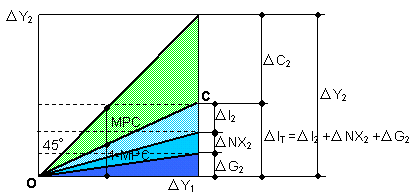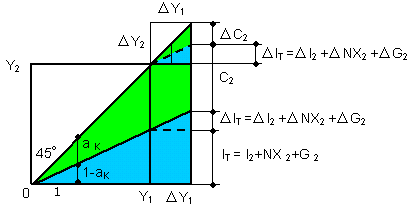|
|
July 1, 2004 |
|
| 5.1
Economic effect of an increase or cut in taxes |
|
The conventional theory is as follows:
|
|
C 2 =
a A + a K ( Y 1 -T1
), T1 : Taxes
(5-1)
|
|
Y2D = C2 + I 2
+ NX 2 + G2
(5-2)
|
|
Substituting Eq.(5-1) into Eq.(5-2) gives, at the Keynesian
cross,:
|
|
Y =a A + a K ( Y 1 -T1
)+ I 2
+ NX 2 + G2
(5-3)
|
|
If we assume that a A , I 2, NX 2
and G2 are constant when Y→Y + ΔY
and T1→ T1+ΔT1 in Eq.(5-3), we
have:
|
|
ΔY/ ΔT1 = - a K / (1
- a K)
(5-4)
|
|
Eq. (5-4) is wrong( incorrect/ flawed). We can't adopt the above-mentioned assumption. Furthermore, we
should know that T1
is a transfer in income. The transfer in income returns to the income through
production, or it moves from some people to other people. These are redistributions of income.
|
|
|
|
We should strictly consider the domain and the range of this
problem. One fiscal time period should be set up. In this period, all
economic data which include incremental taxes should be consistent with
one another.
|
|
|
|
In this analysis, it is assumed
that both net factor income and net transfers,
from abroad are zero. The analysis is possible between NDP and
NDI without the assumption, but we can't use the term "disposable
income". A national government finance is shown
in Table 5-1. This table shows market price.
|
|
|
Table 5-1 National government finance
|
|

|
|
| Taking national government finance into consideration,
we have a table showing NNI and the corresponding production,
(if we
take off debts and credits relationships other than government terms), in
Table 5-2. In this table, the notations on production are shown at factor
cost.
|
|
|
Table 5-2 NNI at factor cost
|
|
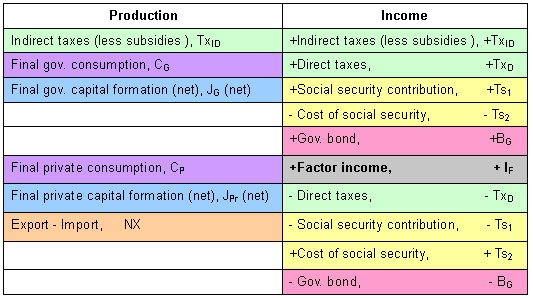
|
|
| Net value added
is equivalent between production and income. Therefore, disposable income is
divided into the government sector and the private sector as shown in Table
5-3. |
|
|
Table 5-3 Dividing of disposable income |
|
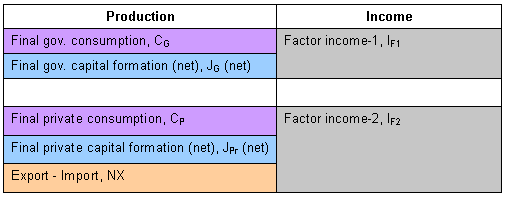
|
| where |
|
IF = IF1 + IF2
(5-5) |
|
| When we express Table
5-2+ with
cash flow, Table 5-2 changes into Table 5-4: |
|
|
Table 5-4 Cash flow |
|
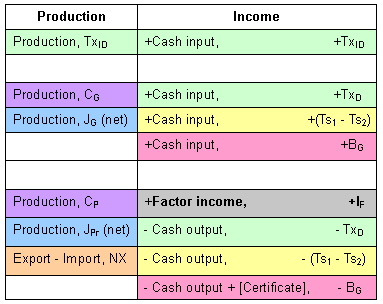
|
|
| If we take away the distribution
role of government, Table 5-4 is transformed into Table 5-5: |
|
|
Table 5-5 Transformation from Table
5-5 |
|
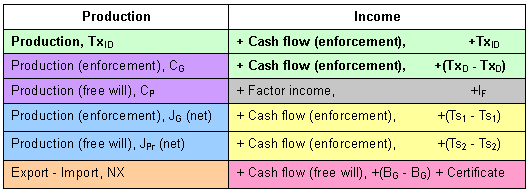
|
|
| In Table 5-5, the word
"enforcement" refers to enforcement by the government. The
word "Certificate" means that it is a bond certificate on which
the government has promised the paying of debts for private people, directly
or via banks. |
|
| From Table 5-4, we obtain: |
| TxID
+ CG + CP + JG(net)
+ JPr (net) + NX |
|
= TxID + (TxD
- TxD) + IF + (Ts1 - Ts1)
+ (Ts2 - Ts2) + (BG - BG) +
Certificate |
|
(5-6) |
| Eq.(5-6) is equivalent
to : |
|
CG + CP + JG (net)
+ JPr (net) + NX = IF +
Certificate
(5-7) |
| Eq.(21) and Eq.(22) are
linear equations, therefore these equations hold between incremental
terms. In
Eq.(21), we can't find the tax
multiplier effect - ( MPC / (1-MPC) ) ·Tax. |
|
| The true
relationship between tax and consumption will be investigated. First of all, incremental indirect
taxes are included in both sides of Eq.(5-6) in the same amount, therefore they don't mathematically affect
production. |
|
| If we increase incremental direct
taxes, some people have to pay the taxes, and they therefore may decrease private
consumption. However, in this case, the government consumption or the net
government investment will increase by the incremental amount of
tax. |
|
| This relationship holds
for the incremental
security transfers. If the incremental security transfer Ts2
increases, those people paying may decrease their consumption, but the
beneficiaries will surely increase incremental consumption. Purchase of
bonds, by original definition, doesn't relate to consumption. Consequently, incremental
taxes don't mathematically effect total consumption. This
phenomenon occurs because both taxes and security transfers are
transfers between some people and other people in income. |
|
| However, this is a mathematical
discussion. It should
be noted that the relationship between all terms in Table 11,
holds among all contracts, and it is executed little by little throughout a
year. In this process, the psychological effect
of taxation may effect private consumption. |
|
|
| This will be explained a
little more deeply. An economic transfer between, for example,
households and a government doesn't affect the total (or
the average) of disposable income. However, it should be noted that
economic activities by people result from the accumulation of each small contract
(or
unit of work). The contract is really the accumulation of unit activity, by a
person and a machine, whose value is
measured by the gross value added. Each contract( or
activity) is generated suddenly , and it increases or grows little
by little. On the other hand, a contract which has finished its
economic role, dies little by little. The economy is made up of vital
activities. Each economic transfer is, as a matter of course, one
of the vital activities, and yet it does not( or hardly) use
economic active energy( GVA).
|
|
|
| In
summation, economic transfers are like
catalysis in the economy, that is to say, enzyme action in biochemical
responses. The catalysis creates an atmosphere in the
economy , and it
accelerates or decelerates economic responses. Catalysts take
effect both for acceleration and suppression of biochemical
responses.
|
|
|
| Economic
transfers are tools for social redistribution of incomes. If economic
transfers are effective for the economy, it will be in a favorable business condition, and vice versa.
To describe this phenomenon,
I used the word "psychological effect", though it would
also be appropriate to use the terms " atmosphere effect" or "
catalysis effect".
|
|
|
| By the way, the
debtor-creditor relationship resembles the transfer relationship in that
both of them are processed between cash and cash in accounts. The
former is accompanied by repayment obligation certificates, but the
latter is executed without conditions. The
debtor-creditor account processing may be interpreted that it is twice
transfer procedures, and what connects the two procedures (time period)
is credit (honor) .
|
|
|
|
In Table 11,
the certificates are, in fact, exchanged
between some people and other people, both of whom now live
but will
not live in the future. However, in Table 10, the
certificates are exchanged between some people
and the government. Consequently, an outstanding government bonds
problem must be resolved within generations where bonds have been issued,
including retired generations.
|
|
|
|
Incidentally, just as economic transfers are tools
of redistribution in income aspect, the
transfers are also tools of redistribution in production. Therefore, the
government bond problem is the income redistribution problem, but at the
same time, it is an industry redistribution problem also.
|
|
|
|
There is a possibility that the above-mentioned logic
is different between free economy and controlled economy, because in the
latter economy, induction of purchase by free will might virtually change into
enforcement by a rationing system.
|
|
|
|
5.2 Two kinds of economic charts
in the national accounts or in business accounts
|
|
|
|
The equations previously defined are rewritten here:
|
|
Y2 = C2 + I 2
+ NX 2 + G 2 |
(5-L1) |
|
Y1 =
TxID+ W+ P + D |
(5-L2) |
|
where TxID =
Taxes less subsidies, W = employees compensation, P = operating surplus
and D = capital depreciation |
|
Y2 = Y1 |
(5-L3) |
|
ΔY2 =Δ
C 2 + ΔI 2
+ ΔNX 2 + ΔG 2 |
(5-L4) |
|
ΔY2 =Δ Y1 |
(5-L5) |
|
|
|
We have two types of economic goods charts. One
is a time-series type( or proportion type) chart, and the other is a break-even type
input-output chart.
|
|
|
|
A time-series type chart in a national account of a fiscal
year is expressed as shown in Fig.5-1.
|
|
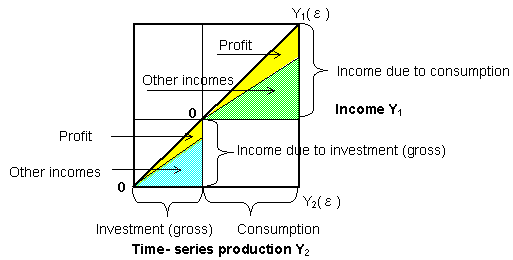
|
|
Fig.5-1 Time-series type
chart
|
|
|
|
In the time-series type chart, even capital depreciation(
death of partial, old capital formations) will, in fact, change with yearly time processes, and at the same time,
new capital
formation (gross), i.e. investment goods will be generated according to the capital
depreciation with new net capital
formation.
|
|
|
|
The horizontal axis shows
realized, cumulative production output. The
vertical axis shows components of realized,
cumulative income( input). The time-series
amount can be monthly cumulative one, or yearly
final one for long years.
|
|
|
|
The characteristics of this chart
are as follows:
|
|
(1) The band width of
operating surplus( 'profit' in Fig.5-1)
shows a part proportion of the wholeY1.
This holds in other components.
|
|
(2)
As the operating surplus is a function of one
variable Y2, Y2 is uniquely
determined for a given operating surplus, if the economy is in a
stationary condition.
|
|
|
|
A break-even type chart is shown in Fig. 5-2.
|
|
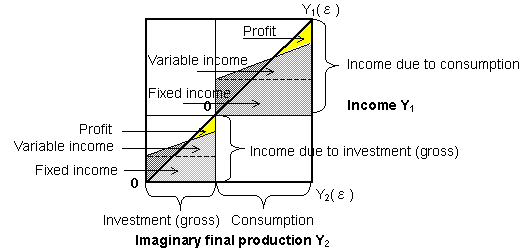
|
|
Fig.5-2 Break-even type chart
|
|
|
|
On the other hand, in the
break-even type input-output chart of a firm, capital depreciation and other fixed
costs are treated as constants within a year. When we
liken a national economic account to an income statement of a firm, we can make
break-even charts for main products, for example, C2 and IT(
investment). In this kind of chart, the realized amount point is for only
the end point which is placed above the final product on the horizontal
axis. The characteristics of this chart are as follows:
|
|
|
|
(1) Any point on the
intermediate
position of the 45 degree line connecting the origin to the end point shows an
imaginary coordinate point( imaginary output, imaginary input).
|
|
(2) The operating surplus( 'Profit' in
Fig.5-2) is a function of
three variables, a fixed income, a variable cost
ratio and a final product Y2. If we take stocks into
consideration in this type of chart, we can draw the 'break-even line' as
described in §1 in "Management Accounting".
|
|
|
|
In both charts, the total input-output points move on
the 45 degree line. As each yearly Y2 is similar in
expression in the two charts, the concepts of these two charts are prone to be misunderstood.
|
|
|
|
The Keynesian's consumption function is made out of
the concept in Fig.5-1. What kind of information can we expect for the
additional government expenditure ΔG from this chart? The answer will be that
the yearly average
proportion of ΔG( revised additional amount) to G (amount on
initial budget) can be calculated.
The income
change corresponding to ΔG is, as a matter of course, the same
amount as ΔG. However, the total income doesn't
change, because ΔG is a transfer between
some people( or firms) and other people( or firms).
|
|
|
|
On the other hand, the input- output table chart in the
national economic accounts is
made out of the concept in Fig.2. Business
entrepreneurs always act in such a manner that they try and get as much
profit as possible depending on the various, present economic
atmospheres (catalysis). Each business
entrepreneur judges his firm's dismissal problem with its break-even
chart, because in this chart, the relationship between costs including
wages and profit( or loss) is expressed.
|
|
|
| Furthermore,
he knows that the time-series type
chart can't give any information to resolve management problems in a unsteady economic
motion. For example, he doesn't get the information of loss information
from the time-series type
chart. In addition, he instinctively knows that a profit is a function
of three variables, fixed costs, efficiency( variable cost ratio) and sales amount.
|
|
|
|
Even If we know a profit in statistical data, we can't know the
background of the profit from the time-series type chart, that is to say
we don't know moving of other two variables than a total sales. On the other hand, in a stationary economic flow, the
time-series type
chart will effectively utilized because it is a simple chart to
understand.
|
|
|
| A national unemployment
problem is same as a dismissal problem in firms. For analyzing the
unemployment problem in a unsteady economic circumstance, the break-even type chart should be used.
|
|
|
|
5.3 Behavior of a two-degrees of freedom system
|
|
The input -output system, with two-degrees of freedom in
an economy, is a simple mathematical problem.
|
|
|
|
Consider the following equation:
|
|
z = x + y
(5-1)
|
|
Suppose that the whole z is composed of its components both x and
y, which then makes a (z, x, y)-system
with a two-degrees of freedom. Let z be a function of time because
this is an economic problem. We consider the following cases:
|
|
case(A) Both x and y are mutually independent variables with respect to time;
|
|
case(B) Only x is a
variable with respect to time, and y
is also a variable but is not so with respect to time.
|
|
|
|
When we add the following one
constraint condition Eq.(5-2) to the (z, x, y)-system, we
can
investigate what occurs:
|
|
x = kz + b
(5-2)
|
|
where k and b are constants with respect to time.
|
|
|
|
From Eq.(5-1) and Eq.(5-2), we have:
|
|
Δz =Δx + Δy
(5-3)
|
|
Δx = kΔz
(5-4)
|
|
From Eq.(5-3) and Eq.(5-4), we
have:
|
|
Δy = (1 - k)Δz
(5-5)
|
|
|
|
In case (A), the (z, x, y)-system
becomes a one-degree of freedom system when the constraint condition Eq.(5-2)
is added to the system. In this system, the
representative variable is Δx, when all the amounts,
Δz, Δx /k, Δx + Δy
and Δy /(1
- k) are the same. This is shown in Fig.5-3 (below) . Note that Δx
can change with respect to
time.
|
|
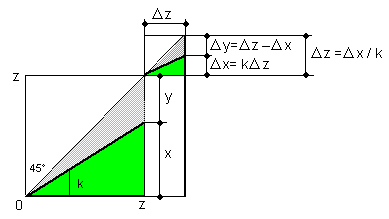
|
|
Fig.5-3
|
|
In case (B), the equations with respect to time can
be solved as follows:
|
|
Δz = Δy / (1 - k)
(5-6)
|
|
Δx = Δy ∙ k / (1 - k)
(5-7)
|
|
where
Δy is a variable which is independent of a change in
time. The word 'solved' means that
variables with respect to time are already determined or time stopped. Only
Δy can change, which is a function of a factor other than time, for
example, the accidental nature of peoples' will. Δy
must always be determined in the beginning of the change Δz. The
whole
Δz must be linked to only Δy. Note that Δx in Eq.(5-7)
should automatically be generated at the same time as
Δy is generated, because
Δx can't change any longer with time.
|
|
|
|
This is shown in Fig.5- (below).
|
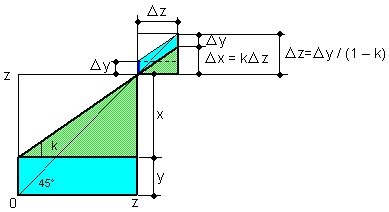
|
|
Fig.5-4
|
|
|
|
case(C) Both x and y are mutually independent variables with respect to
time. x is divided into two parts, as in x = x1+ x2. At
the same time, Eq.(5-2) holds;
|
|
We denote x as:
|
|
x = x1 + x2
(5-8)
|
|
Eq.(5-1) and Eq. (5-8) give:
|
|
z = x1 + x2 + y
(5-9)
|
|
Eq.(5-9) with Eq.(5-2) seems to be a 2-degrees of freedom system.
However, both x1 and x2 are one pair of (x1, x2)
which satisfies Eq.(5-8). Thus, the system with both
Eq.(5-9) and Eq.(5-2) is one-degree of freedom system.
|
|
|
|
case(D) Only x is a
variable with respect to time. y
is also a variable but is not so with respect to time; y is divided
into two parts as y= y1+y2; At the same time, Eq.
(5-2) holds.
|
|
We denote Y as follows:
|
|
y = y1 + y2
(5-10)
|
|
As shown in Eq. (5-9), we have:
|
|
z = x + y1 + y2
(5-11)
|
|
As both y1 and y2
are halves of the pair (y1, y2), which satisfies
Eq.(5-10), this system is also a one-degree of freedom system.
|
|
|
|
The important point of the two cases, (case(C) and
case(D)), is that, for example, both the variables y1 and y2 are
halves of (y1, y2).
Consequently, when we select y1 as a variable in this system,
we have to remember the existence of y2, and have to provide y2
in the system.
|
|
|
|
5. 4 A reconsideration of the ΔY1
= ΔI2 / (1 - MPC) chart problem
|
|
Using the assumption ΔG2 =
ΔNX2 = 0 in Fig.3-2, we can obtain Fig.5-5 where ΔI2
is expressed as ΔIT. We can also get the same
chart when we assume that ΔG2 and
ΔNX2 are included in ΔIT. This chart is used in the economic model which J. M. Keynes adopted in his original
work, although he didn't show its model chart. We shall call this chart 'Keynes'
original chart'.
|
|
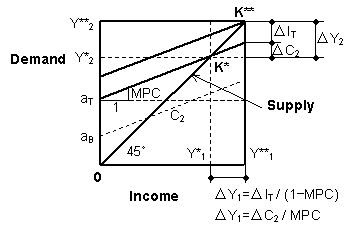
|
|
Fig.5-5 Keynes'
original chart
|
|
|
|
In Keynes' original chart,
the Keynesian cross condition is satisfied. Is there any strange point in
this chart in the time series real economy when the MPC exists?
|
|
|
|
When we analyze an unemployment problem using Keynes'
original chart, several important shortcomings occur.
|
|
|
|
We will examine the validity of Keynes'
original chart using the argument shown in 5.3. We apply the
following notations:
z = Y2, x = C2,
y = IT and k = MPC. Keynes' original chart corresponds to
the case(B) or the case(D) in 5.3.
|










